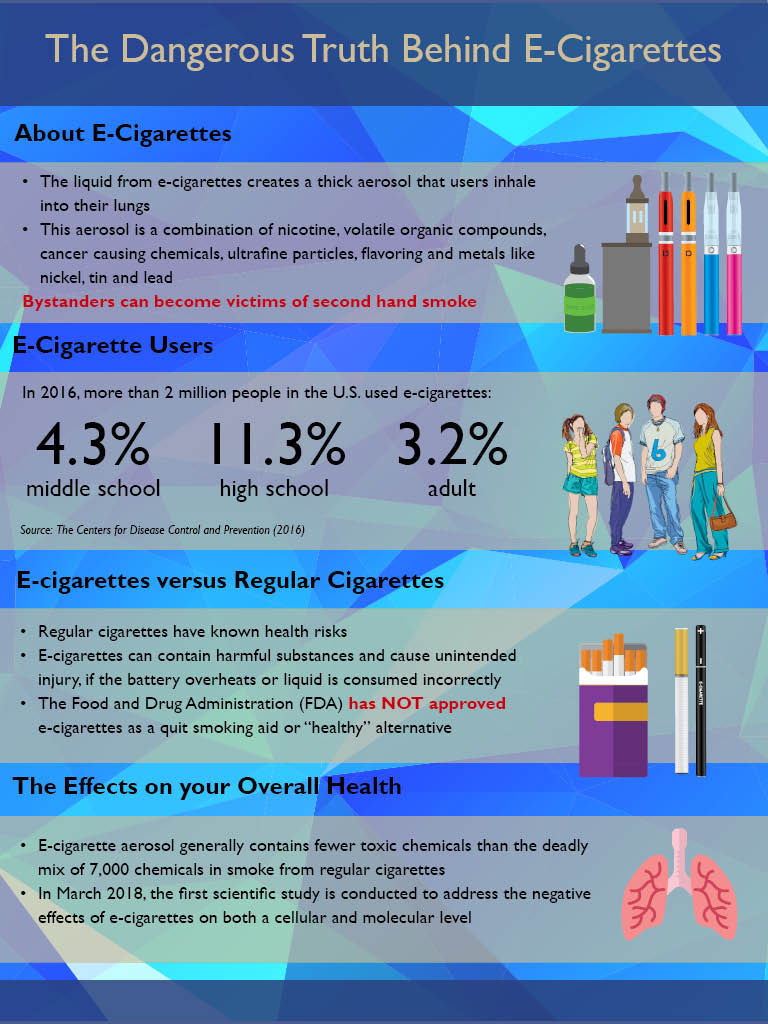E-cigarettes, also known as “vapes”, come in many shapes and sizes. Most have a battery, a heating element, and a place to hold liquid. The liquid usually contains nicotine or tobacco and a flavor. When it is heated, the liquid creates a thick aerosol that users inhale into their lungs. Bystanders can also breathe in this aerosol when the user exhales into the air.
In the United States, teenagers are more likely than adults to use e-cigarettes.
According to the Centers for Disease Control and Prevention (CDC) in 2016, more than 2 million U.S. middle and high school students used e-cigarettes in the past 30 days. This includes 4.3% of middle school students and 11.3% of high school students, while only 3.2% of U.S. adults were current e-cigarette users.
While in 2015, among adult e-cigarette users overall, 58.8% were also daily cigarette smokers, 29.8% were former daily smokers, and 11.4% had never been daily cigarette smokers.
E-cigarettes first emerged in 2004 as a new “healthier” alternative for tobacco smokers. Early studies showed that e-cigarettes had less of an impact on overall health compared to smoking conventional cigarettes. However, growing evidence from research suggests that there are potential consequences.
The U.S. Preventive Services Task Force, a group of health experts that make recommendations about preventive health care, has concluded that evidence is insufficient to recommend e-cigarettes as a quit smoking aid in adults, including pregnant women. As a result, the Food and Drug Administration has not approved e-cigarettes as a quit smoking aid or alternative.
In 2015, a letter from the New England Journal of Medicine expressed concern over formaldehyde, a toxic compound found in the vapors produced by e-cigarettes.
At the University of Rochester (UR) Medical Center a study, funded by the National Institutes of Health, suggests that electronic cigarettes are as equally damaging to gums and teeth as conventional cigarettes.
The study, published in Oncotarget, was led by Irfan Rahman, Ph.D. professor of Environmental Medicine at the UR School of Medicine and Dentistry, and is the first scientific study to address e-cigarettes and their negative effect on oral health on both a cellular and molecular level. Previously, scientists thought that the chemicals found in cigarette smoke, like formaldehyde, were the culprits behind adverse health effects, but growing scientific data suggests otherwise.
“We showed that when the vapors from an e-cigarette are burned, it causes cells to release inflammatory proteins, which in turn aggravate stress within cells, resulting in damage that could lead to various oral diseases,” explained Rahman “How much and how often someone is smoking e-cigarettes will determine the extent of damage to the gums and oral cavity.”
The study exposed 3-D human, non-smoker gum tissue to the vapors of e-cigarettes and found that the flavoring chemicals also play a role in damaging cells in the mouth.
“We learned that the flavorings–some more than others–made the damage to the cells even worse,” added Fawad Javed, from Eastman Institute for Oral Health, part of the UR Medical Center. “It’s important to remember that e-cigarettes contain nicotine, which is known to contribute to gum disease.”

The Truth behind E-Cigarettes
